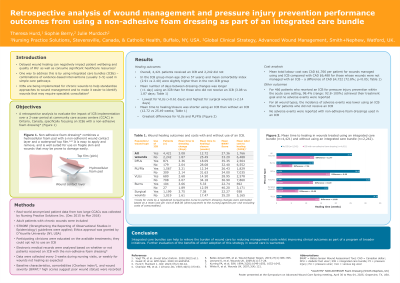Clinical Research
(CR-035) Retrospective Analysis of Wound Management and Pressure Injury Prevention Performance Outcomes from Using a Non-adhesive Foam Dressing as Part of an Integrated Care Bundle
Friday, May 2, 2025
7:45 PM - 8:45 PM East Coast USA Time

Sophie Berry, BSc (Hons); Julie Murdoch, PhD
Introduction: Medical adhesive-related skin injuries are defined as to skin damage caused by the use of products containing a medical adhesive1. Patients with fragile and/or sensitive skin, may require use of low or non-adherent dressings to help reduce the risk of damage. Integrated care bundles (ICBs) are interventions that used together synergistically improve wound care outcomes.
This study assessed wound management outcomes and impact on pressure injury (PI) prevention protocols using a non-adhesive foam dressing as part of an ICB.
Methods: A comprehensive wound care program using ICBs was implemented at two large healthcare organizations in Ontario, Canada in December 2015, and its progress was tracked until March 2018. Anonymized patient data were analyzed retrospectively.
Results: 4,421 patients with chronic wounds received an ICB including a non-adhesive foam dressing; 2,242 patients did not receive an ICB. With use of the ICB including a non-adhesive foam dressing versus no ICB: mean time to healing was shorter (12.7 vs 25.5 weeks), mean time between dressing changes was longer (3.1 vs 1.9 days), and mean Bates-Jensen Wound Assessment Tool (BWAT) Score was lower (27.4 vs 33.2) at end of treatment. Mean labour costs were lower with use of the ICB including a non-adhesive foam dressing (CAD 1,766 vs 6,488; p< 0.05). 466 patients received the ICB including a non-adhesive foam dressing for PI prevention and 98.4% achieved treatment goal at discharge. No adverse events related to the non-adhesive foam dressing were reported.
Discussion: Use of an ICB incorporating this non-adhesive foam dressing improved wound management outcomes and reduced mean labour costs compared with not using an ICB.
This study assessed wound management outcomes and impact on pressure injury (PI) prevention protocols using a non-adhesive foam dressing as part of an ICB.
Methods: A comprehensive wound care program using ICBs was implemented at two large healthcare organizations in Ontario, Canada in December 2015, and its progress was tracked until March 2018. Anonymized patient data were analyzed retrospectively.
Results: 4,421 patients with chronic wounds received an ICB including a non-adhesive foam dressing; 2,242 patients did not receive an ICB. With use of the ICB including a non-adhesive foam dressing versus no ICB: mean time to healing was shorter (12.7 vs 25.5 weeks), mean time between dressing changes was longer (3.1 vs 1.9 days), and mean Bates-Jensen Wound Assessment Tool (BWAT) Score was lower (27.4 vs 33.2) at end of treatment. Mean labour costs were lower with use of the ICB including a non-adhesive foam dressing (CAD 1,766 vs 6,488; p< 0.05). 466 patients received the ICB including a non-adhesive foam dressing for PI prevention and 98.4% achieved treatment goal at discharge. No adverse events related to the non-adhesive foam dressing were reported.
Discussion: Use of an ICB incorporating this non-adhesive foam dressing improved wound management outcomes and reduced mean labour costs compared with not using an ICB.

.jpg)